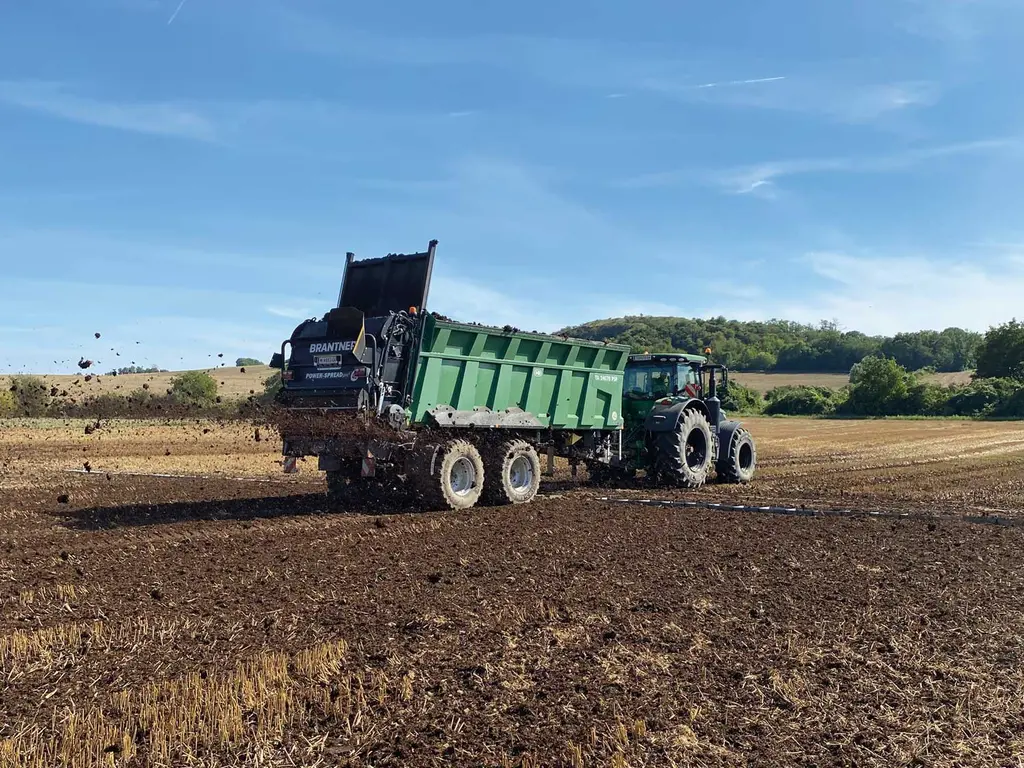Download print version
Test report 7271
The approval
A test mark „DLG-APPROVED for individual criteria“ is awarded for agricultural products which have successfully fulfilled a scope-reduced usability testing conducted by DLG according to independent and recognised evaluation criteria. The test is intended to highlight particular innovations and key criteria of the test object. The test may contain criteria from the DLG test scope for overall tests, or focus on other value-determining characteristics and properties of the test subject. The minimum requirements, test conditions and procedures as well as the evaluation bases of the test results will be specified in consultation with an expert group of DLG. They correspond to the recognised rules of technology, as well as scientific and agricultural knowledge and requirements. The successful testing is concluded with the publication of a test report, as well as the awarding of the test mark which is valid for five years from the date of awarding.
The DLG test series „Efficiency assessment of premium tyres“ explores the performance of agricultural tyres in various scenarios. The tests measure tractive performance and specific fuel consumption of a tractor while it is carrying out field work and transport work.
In the test discussed below, the Soil King VF model from Nokian Tyres was compared with three different sets of premium brand tyres. The tyre sizes tested were VF600/70R30 (front) and VF710/70R42 (rear). The Soil King VF tyre from Nokian Tyres has a new center line pattern design. These traction/AS pattern with center-line pattern design (lug tips) intended to provide smooth ride properties on the road. At the same time, the tread features the typical lugs of field tyres (referred to as AS tyres in the following discussion) on both sides of the center line pattern. This combined road/field tread pattern is intended to provide both the smooth ride properties of a road tyre and the traction and self-cleaning properties of AS tyres in field work. Apart from that, the Nokian Tyres Soil King VF is classified as a VF tyre (Very High Flexion), which means that its load capacity is substantially higher than that of a regular tyre – both at identical inflation pressures and at a reduced inflation pressure.
The Soil King VF tyre was compared against three sets of AS tyres from premium brand manufacturers. Two of these three sets are also classified as VF tyres (reference A and reference B) whereas the third set of reference tyres (reference C) are classified as IF (Improved Flexion). This type of tyre has a 20 % higher load capacity than a tyre that is neither IF nor VF. VF tyres offer a 40 % higher load capacity.
Other criteria were not investigated.
Assessment in brief
In the comparison test with three reference tyre sets, the Nokian Tyres Soil King VF achieved the best results in the group. In the field test, the tyres by Nokian Tyres delivered the highest tractive performance and the lowest specific consumption rate in the prevailing test conditions.
The same applied to the road transport test in which the specific fuel consumption was also the lowest within the test group of three reference tyre sets. In addition, the tyres also produced a low wheel slip in the field and on the road.
Table 1: Assessment in brief
| DLG quality profile | Evaluation* |
|---|---|
| Fuel consumption in transport work | ■■■■■ |
| Fuel consumption in field work | ■■■■■ |
| Ha/h performance | ■■■■■ |
| Wheel slip in transport and field work | ■■■■■ |
* DLG Evaluation range:
■■■ or better = meets, exceeds or significantly exceeds the established DLG standards,
■■ = meets the legal requirements for marketability
■ = failed
The method
The test consisted of two partial tests, one focusing on field work and one on transport work. The tyres were fitted to a Fendt 828 Vario (referred to as the ‘test tractor’ in the following discussion). This had a reversible fan which was set electronically to maximum output, a measure that ensured the fan was absorbing identical amounts of power in all test runs. Before the tests started, the test tractor’s pto output was measured on the pto test stand at the DLG Test Center. As anticipated, the maximum pto output was 195kW. The tractor’s dead weight is 10 tonnes in transport work and 13.5 tonnes in field work for which it was ballasted with weights. The implement was simulated by a John Deere 8345R which was pulled by the test tractor. This is referred to as the braking tractor in the following discussion. This braking tractor was ballasted to a 16 t gross weight. The transport work tests were carried out by the test tractor pulling a trailer with a gross weight of 14 t after being loaded with a concrete block. This load corresponded to the pto output recorded on the test stand. The gross weight of this transport combination was more than 24 tonnes.
The field test was carried out in a field of the international cropping centre near Bernburg. The first part of this test took place in short and uniform wheat stubbles and the second part on cultivated ground. The soil was black loess soil, the average moisture level was 30 % at a 10cm depth.
The tests described below were carried out on two consecutive days, ensuring that all tyres were tested in identical conditions. The braked tractor was attached to the test tractor by a steel rope to which a load cell was attached. This allowed the testers to apply a defined load on the test tractor thereby simulating a specific implement. The distance covered by the combination and the current forward speed were measured by a Peiseler wheel. The fuel consumption was measured by a Kral BEM500 fuel meter that uses two threaded spindles. This measures the tractor’s fuel consumption by obtaining the difference between the amount of fuel supplied through the feed line and that returning through the return line. The tractive performance is determined by using the tractive force and forward speed. The specific fuel consumption is obtained by dividing the consumption rate per hour by the traction measurement. All tyres on the test tractor were deflated to 0.6 bar and four-wheel drive and diff locks were engaged. The wheel rotations were measured on one rear wheel using a Wachendorff increment sensor. By measuring the number of wheel rotations and the circumference of the wheel it is possible to calculate the wheel slip based on roll rate and ground speed.
To determine the performance of the individual tyres in the best possible way in the first part of the field test, the testers applied a tractive force of 51 kN on the braked tractor. This is a typical measure in stubble work. As the maximum tractive performance is measured over a course of several hundred metres, it is possible to calculate the specific consumption and ha/h performance. The ha/h performance defines the area that is covered by the machine during one hour while carrying out the referenced cultivation. This test was carried out in wheat stubbles. In the second part of the field test, the test machine was operated in cultivated soil at an initial speed of 6 km/h. The work load increased progressively so that it was possible to measure the wheel slip relative to the current work load.
In the second part of the test – the transport test – the combination had to perform in two different scenarios: transport work up various slope gradients and transport work in flat land. The uphill test consisted of six uphill runs on slopes with various gradients which made different demands on the test machine.
These courses reflected typical situations: long and gentle slope gradients with intermittent sections of flat land, plus short and steep courses. All uphill runs were carried out at full load. This means that the forward speeds at which the uphill runs were carried out differed by the individual transmission ratios. In the runs in flat land the performance is additionally tested at half load. Under comparable conditions, this result offers some guidance for assessing the rolling resistance.
Transport work in flat land was carried out at two different speeds – 50 km/h and 60 km/h. This setup is intended to reveal two things – the potential of fuel savings by reducing the forward speed on the one hand and the fact that the tyre performance varies depending on the ground speed on the other.
All tests were carried out at similar outside temperatures and on dry roads. In all test runs the tyres were inflated to the standard 1.6 bar pressure. The test tractor was driving in rear-wheel drive mode. The wheel rotations were measured on both wheels to determine the wheel slip. The distance travelled and forward speed were measured by an optical Correvit sensor. The force was measured by a Kistler load cell inside the drawbar.
The test results in detail
The field test results reveal that in the prevailing test conditions the Nokian Tyres Soil King VF achieved the highest tractive performance. This is reflected by the specific fuel consumption rate that is shown in Figure 6. In this category, the Nokian Tyres Soil King VF achieved the best test results within the reference group. The consumption rates measured for the AS reference tyres were more or less on the same level in all tests. The levels of the Nokian Tyres Soil King VF were lower than the reference results. On the other hand, when looking at the ha/h performance as a direct measure of tractive force, it is clear that the Nokian Tyres Soil King VF also develop a higher traction, which is shown in Figure 7. The ha/h performance describes the area that is covered by the machine during one hour by applying the tractive force that is adequate to pull a cultivator. The working width of the implement used in this test is 5 m. The ha/h performance is the parameter that expresses the productivity of a tractor clad with a specific set of tyres. High traction means that the drive power is efficiently transfered to the ground by the tyres. Figure 8 shows the results of the wheel slip measurements. These show that wheel slip was lowest on the Nokian Tyres Soil King VF. Low wheel slip resulted in a greater efficiency than it was provided by the reference tyres. This may explain the outstanding tractive performance.
Nokian Tyres Soil King VF also achieved the best results in the transport test. The overall result is plotted in Figure 9. This is derived at by using the mean uphill result and the flat land results at 50 km/h and 60 km/h. In these test runs, the Nokian Tyres Soil King VF achieved a better result at 60 km/h than the reference tyres at 50 km/h. At the same time, the tyre scored best in the overall transport test, the uphill tests and in the flat land tests.
Some of this good performances in transport work can be explained by the new design of the Nokian Tyres Soil King VF, which has new center line pattern design in the middle of the tyre. These traction/AS pattern with center-line pattern design (lug tips) intended to provide smooth ride properties on the road, better than the relatively slim lugs on AS tyres. The lugs on AS tyres have a greater tendency to deform when rolling on tarmac and when operating under load than the lugs on new profile of Nokian Tyres Soil King VF have. This specific type of deformation is referred as mould slip. Mould slip and wheel slip add up when the machine is travelling on tarmac. Figure 10 shows that wheel slip was smallest on the Nokian Tyres Soil King VF tyre. As the total wheel slip translates into power loss, a reduction in wheel slip translates into more drive power. Although wheel slip is only one of several parameters that describe the power loss on tyres, it does offer an insight into the mechanisms that cause tyres to lose some of the drive power.
The set of Nokian Tyres Soil King VF tyres – VF600/70R30 on the front axle and VF710/70R42 on the rear axle – proved to be very efficient tractor tyres in all tests. The comparison of this tyre with three different premium brand AS tyres showed that the Nokian Tyres Soil King VF achieved the best results both in the field and road tests.
In the field test, the Nokian Tyres Soil King VF tyre achieved the best tractive performance and the lowest specific fuel consumption in the prevailing soil conditions, thereby performing better than the reference tyres. In the transport test, the tyre reproduced the good results in the field, scoring the best road result in the group.
In the field tests and in the transport tests, the wheel slip was exceptionally low. This translates into an efficient power transfer from the tyre to the road or ground.
Manufacturer and applicant
Nokian Heavy Tyres Ltd.
Test performed by
Testing agency
DLG TestService GmbH, Gross-Umstadt location, Germany
The tests are conducted on behalf of DLG e.V.
Head of Department
Stefano Mastrogiovanni
DLG test framework
Fahrzeugtechnik
Test engineer(s)
Daniel Peters *
*Author
Contact us
DLG TestService GmbH - Groß-Umstadt location • Max-Eyth-Weg 1 • 64823 Groß-Umstadt • Tel: +49 69 24 788-600 • tech@DLG.org
























